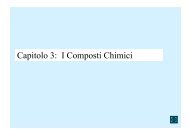Giorgio Astara 2-32.pdf - Università degli studi di Cagliari.
Giorgio Astara 2-32.pdf - Università degli studi di Cagliari.
Giorgio Astara 2-32.pdf - Università degli studi di Cagliari.
Create successful ePaper yourself
Turn your PDF publications into a flip-book with our unique Google optimized e-Paper software.
In principio era il dolore…<br />
<strong>Giorgio</strong> <strong>Astara</strong><br />
Oncologo Me<strong>di</strong>co<br />
Policlinico Universitario<br />
Università <strong>degli</strong> Stu<strong>di</strong> <strong>di</strong> <strong>Cagliari</strong>
In principio era il<br />
dolore…<br />
Il dolore è una percezione soggettiva<br />
sgradevole…
Tipi <strong>di</strong> dolore<br />
Dolore Fisiologico<br />
Acuto<br />
Nocicettivo<br />
Corretta risposta<br />
<strong>di</strong> adattamento,<br />
essenziale<br />
per evitare danni<br />
tissutali<br />
Dolore Patologico<br />
Cronico<br />
Neuropatico e<br />
infiammatorio<br />
Alterata risposta<br />
<strong>di</strong> adattamento ad un<br />
danno tissutale, nervoso<br />
o non nervoso
ACUTO<br />
Dolore<br />
CRONICO<br />
La <strong>di</strong>fferenza tra dolore acuto e cronico<br />
non è quin<strong>di</strong> stabilita da un dato<br />
temporale, ma è bensì collegata alla<br />
capacità o meno dell’organismo <strong>di</strong><br />
guarire<br />
la lesione traumatica e <strong>di</strong> riportare alla<br />
norma<br />
le afferenze sensoriali e gli eventi<br />
scatenati<br />
nel sistema nervoso centrale.
Scala OMS per il dolore cronico<br />
oncologico<br />
Libertà dal dolore da cancro<br />
Oppioi<strong>di</strong> per dolore moderato-severo<br />
± Non oppioi<strong>di</strong><br />
± A<strong>di</strong>uvanti<br />
Dolore che persiste o cresce<br />
Oppioi<strong>di</strong> per dolore lieve-moderato<br />
± Non oppioi<strong>di</strong><br />
± A<strong>di</strong>uvanti<br />
Dolore che persiste o cresce<br />
Non oppioi<strong>di</strong><br />
± A<strong>di</strong>uvanti<br />
Le terapie me<strong>di</strong>che rimangono il fondamento<br />
per la gestione del dolore cronico oncologico.<br />
3<br />
2<br />
1
Percentuale e grado <strong>di</strong> dolore in<br />
pazienti con cancro in sta<strong>di</strong>o<br />
avanzato<br />
Lieve 20-35% Moderato-grave 40-50% Gravissimo 25-30%
Problemi legati al dolore<br />
neoplastico<br />
Leggere un<br />
libro<br />
14%<br />
Stare con la<br />
gente<br />
27%<br />
Fare qualsiasi<br />
cosa<br />
7%<br />
Guardare la<br />
TV<br />
12%<br />
Sedere più <strong>di</strong><br />
15 minuti<br />
18%<br />
Dormire<br />
22%
Han<strong>di</strong>caps legati al dolore<br />
neoplastico<br />
Pulire<br />
10%<br />
Camminare<br />
su strada<br />
5%<br />
Salire e<br />
scendere<br />
scale<br />
8%<br />
Shopping<br />
9%<br />
Vestire<br />
8%<br />
Camminare<br />
in campagna<br />
19%<br />
Correre<br />
26%<br />
Cucinare<br />
7%<br />
Lavare<br />
8%
Atteggiamenti <strong>degli</strong> oncologi<br />
francesi nella prescrizione<br />
<strong>di</strong> morfina<br />
%<br />
Sod<strong>di</strong>sfazione per le proprie attitu<strong>di</strong>ni<br />
nel trattamento del dolore<br />
93<br />
Riluttanza all’utilizzo <strong>di</strong> morfina<br />
50<br />
oncologi pazienti<br />
Prevalenza del dolore<br />
Sod<strong>di</strong>sfazione<br />
Morfina nel dolore severo<br />
Larue, Cancer, 1995 - Larue, BMJ, 1995<br />
21 - 30<br />
57<br />
93 49<br />
78<br />
41
Un adeguato trattamento del dolore<br />
oncologico è in rapporto a:<br />
• Causa<br />
• Sede<br />
• Qualità ed intensità<br />
• Presenza <strong>di</strong> metastasi<br />
• Progressione della malattia
Scelta terapeutica nel dolore<br />
oncologico<br />
1] TIPO DI DOLORE<br />
• Nocicettivo<br />
• Neuropatico<br />
• Misto<br />
2] CARATTERE DEL DOLORE • Incident<br />
• Non incident<br />
• Breakthrough pain<br />
3] DISTRIBUZIONE DEL DOLORE<br />
4] CARATTERISTICHE DEL PAZIENTE
Quando trattare il<br />
dolore da cancro<br />
tollerabile<br />
0% ---------<br />
no<br />
non tollerabile<br />
50% --------- 100%<br />
si<br />
----- 50%<br />
in fase precoce
SEMPRE
Il dolore oncologico è un<br />
dolore totale…<br />
1. Componente nocicettiva<br />
2. Componente organica<br />
3. Componente neuropatica<br />
4. Componente psicogena<br />
5. Componente sociale<br />
6. Componente spirituale
TRATTAMENTI<br />
CHIRURGICI<br />
OPPIOIDI FORTI<br />
OPPIOIDI +/- FANS<br />
+/- ADIUVANTI<br />
FANS +/- ADIUVANTI
FANS<br />
COXIB <br />
ALTRO <br />
Oppioi<strong>di</strong> forti<br />
+/- FANS<br />
Oppioi<strong>di</strong> deboli<br />
+ FANS<br />
Dolore<br />
me<strong>di</strong>o<br />
Dolore<br />
severo<br />
oppioi<strong>di</strong><br />
NMDA-rec<br />
antag.<br />
Bloccanti Ca ++<br />
altro <br />
FANS<br />
Dolore moderato<br />
+/- ADIUVANTI
Am J Ther. 2004 Sep-Oct;11(5):354-65.<br />
Opioid therapy and immunosuppression: a review.<br />
Vallejo R, de Leon-Casasola O, Benyamin R.<br />
Research Program, Millennium Pain Center, Biology Department, Illinois State<br />
University, Bloomington-Normal, USA. vallejo1019@yahoo.com<br />
Acute and chronic opioid<br />
administration is known to have<br />
inhibitory effects on humoral and<br />
cellular immune responses<br />
inclu<strong>di</strong>ng antibody production,<br />
natural killer cell activity,<br />
cytokine expression, and<br />
phagocytic activity.
Opiates behave like cytokines,<br />
modulating the immune response by<br />
interaction with their receptors in the<br />
central nervous system and in the<br />
periphery. Potential mechanisms by<br />
which central opiates modulate<br />
peripheral immune functions may<br />
involve both the hypothalamicpituitary-adrenal<br />
axis and the<br />
autonomic nervous system.
The presence of opioid receptors outside<br />
the central nervous system is<br />
increasingly recognized. Those<br />
receptors have been identified not only<br />
in peripheral nerves but also in immune<br />
inflammatory cells.
Opiates may also promote<br />
immunodeficiency virus infection<br />
by decreasing the secretion of<br />
alpha and beta chemokines<br />
(important inhibitory cytokines for<br />
the expression of HIV) and at<br />
the same time increasing the<br />
expression of chemoreceptors<br />
CCR5 and CCR3, coreceptors for<br />
the virus.
• The fact that peripheral<br />
immunosupression is me<strong>di</strong>ated at least<br />
in part by opioid receptors located in<br />
the central nervous system and that<br />
intrathecally administered opioids do<br />
not exert the same immunosuppressive<br />
effects may have important clinical<br />
implications for those patients<br />
receiving long-term opioid therapy for<br />
malignant and nonmalignant pain.
TRATTAMENTO INTEGRATO<br />
CITOCHINE<br />
CACHETTIZZANTI<br />
TNF, IL-6, IL-1,<br />
IFNγ<br />
FATTORI<br />
TUMORALI<br />
PIF, LMF<br />
CACHESSIA<br />
CONCLAMATA<br />
INNESCO<br />
CACHESSIA<br />
PROGRESSIONE<br />
MALATTIA NEOPLASTICA
Cachessia<br />
Progressione <strong>di</strong> malattia<br />
OPPIOIDI FORTI<br />
+/- ADIUVANTI +/- MAP<br />
+/- FANS<br />
OPPIOIDI FORTI<br />
+/- ADIUVANTI +/- MAP<br />
OPPIOIDI FORTI<br />
+/- ADIUVANTI<br />
TRATTAMENTI INVASIVI<br />
Con<strong>di</strong>zionamento<br />
e immunomodulazione
The Ladder into the 21 st Century<br />
WHO Pain Pyramid<br />
Neurolytic<br />
block<br />
Intrathecal<br />
IV, SC PCA<br />
pump<br />
5%<br />
10-20%<br />
IV, SC PCA<br />
10-20%<br />
switching<br />
<strong>degli</strong> oppioi<strong>di</strong><br />
TD Fent,<br />
Strong Op<br />
Opioids<br />
+/-<br />
adjuvants<br />
NSAIDs<br />
75-85%


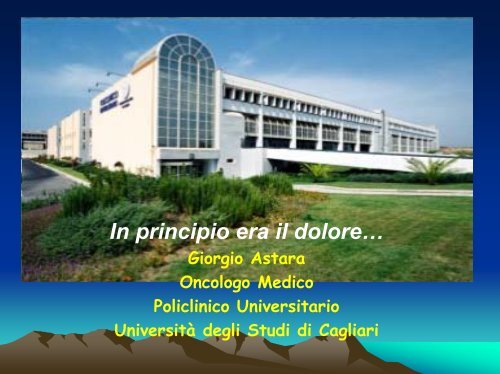
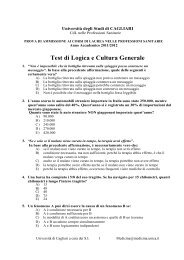


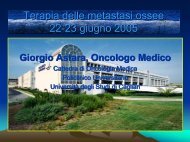
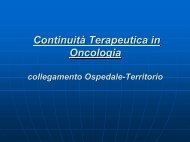
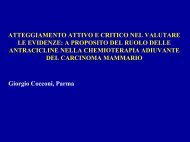

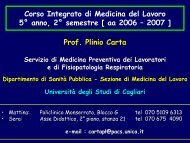
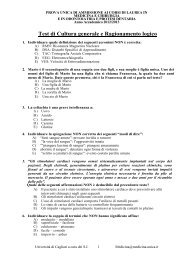

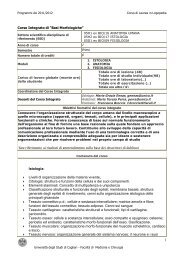
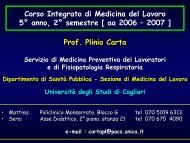
![Appunti dalle Lezioni di Neuroanatomia. [pdf] - Medicina](https://img.yumpu.com/15986763/1/184x260/appunti-dalle-lezioni-di-neuroanatomia-pdf-medicina.jpg?quality=85)
